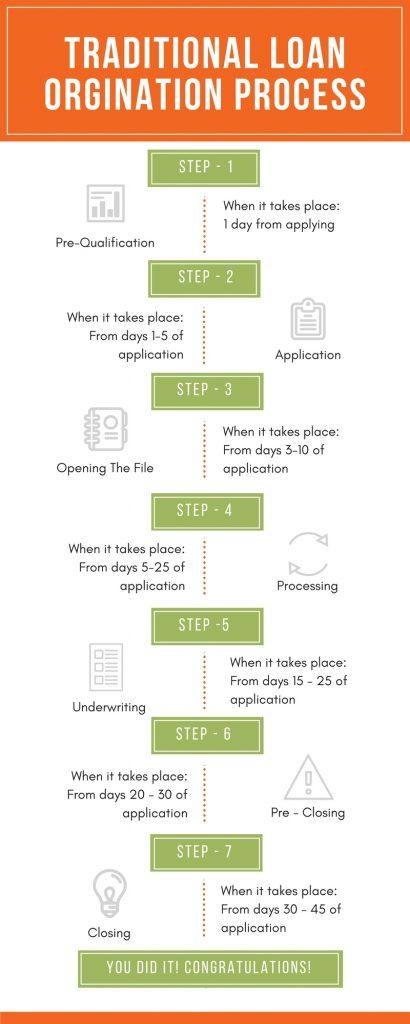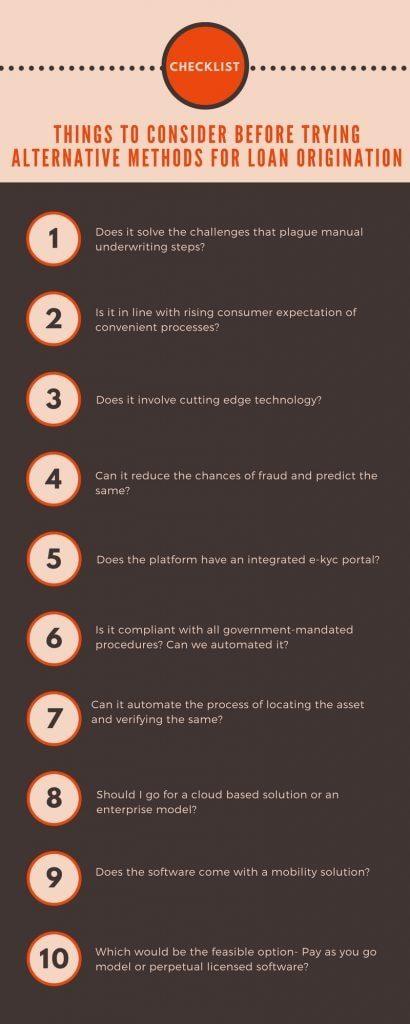Latest Trends in LOS
Latest Trends in LOS
BY INFOSPOKE
When it comes to the purchase of assets such as vehicles or real-estate, the requirement of capital to buy an entire asset out of savings is impractical. For buyers who look to purchase such as assets in a short-time period, availing loans is the easiest method to raise capital for such massive investments.
However, if one has spent time trying to avail a loan in the past, one must be quite aware of the time it takes for the loan amount to be disbursed. While borrowers may assume that this is an avoidable delay by the lender, the truth is that lenders do not provide loans in an ad hoc manner.
For every loan to go from the stage of applying for the loan by the potential borrower to the final release of funds, there are several crucial steps in the process that lenders adhere to before parting with capital. These methods are referred to as Loan Origination, involves a thorough verification of borrower’s credentials and the risk involved in the retrieval of the loan before the loan gets approved (or declined, in cases where there is a trust deficit).

There are six distinct phases in the traditional loan origination process:
- Pre-Qualification: It is a screening process in which the current finances and debts of a client are processed before they file a loan application. (When it takes place: 1 day from applying)
- Application: It refers to the first step of the process where an applicant files his request for a loan alongside the purpose of the loan. (When it takes place: From days 1-5 of application)
- Opening The File: It involves gathering and screening of all the information furnished by the borrower and verifying its authenticity. (When it takes place: From days 3-10 of application)
- Processing: Here, all the information is screened and checked for discrepancies. If any discrepancies are found, the borrower is asked for a written explanation. (Time: 5-25 days)
- Underwriting: The “processor” sends his comments and findings to his who decides upon whether or not to approve the loan. (When it takes place: From days 15-25 of application)
- Pre-Closing: During this time, title insurance is allocated for the loan along with other contingencies. The time for closing the loan is also fixed. (Time taken: From days 20-30)
- Closing: All loan processing formalities are completed at this stage and the lender funds the loan for the borrower in exchange for the title of the property. (Time taken: From days 30-45)

Benefits of the Traditional Loan Origination Process :
- The traditional processes which were discussed above are quite elaborate in their screening of a borrower and approval of a loan.
- These processes have been set in place partly due to policies and partly to avoid potential defaulters from receiving loans in the first place.
- They thoroughly evaluate the ability of a borrower to repay the loan before the funds are disbursed.
Challenges and Shortcomings in Traditional Loan Origination Process :
While this process is effective, most of it is still involves a lot of arduous paperwork and manual screening which can be quite cumbersome for both borrowers and lenders. Another major constraint is the time. From the applying of a loan by the borrower to the time when the funds are actually wired to him/her, it takes an average span of 35-40 days.
Such a long time deters most borrowers for taking up this process. While this varies for different types of loans, mortgage loans are notorious for the amount of time taken by the lender before the process is completed.
While most of the aforementioned challenges can be brushed aside as necessary hassles, the key constraint is the fact that most of these processes are dependent on the credit bureau for verification and that brings with it a lot of challenges faced by a “hub and spoke” system. Also, the time absorbed by the process does not account for accuracy.
The system is still prone to errors and the chances of malpractice cannot be ruled out completely. Hence, there has always been a need to find alternatives for such effort-intensive processes and minimise the time taken for the complete loan origination process.
When it comes to identifying the latest trends in loan origination systems, the following criteria need to be weighed in before deciding upon their merits or demerits.
These are some of the common criteria that are used by lenders who are either looking for a way to digitize their loan origination process or hunting for a new technology to integrate with their existing loan origination systems.

Latest Trends in Loan Origination
Thanks to the improvement in the speed of internet networks and the advent of cloud computing, origination as a process can now move from the realm of manual operations to the cloud. Several players in the industry refer to this as Digitalised Origination and industry experts believe that this is where the trend is heading towards.
What is Digital Origination?
Digital Loan Origination refers to the digital processes that undertake hitherto manual loan origination processes such as loan application filling, a collection of supporting data. It is a process flow that covers the entire gamut of loan origination digitally and strives to keep the paperwork to a minimum. This, it hopes to achieve by digitizing all existing manual processes and lay the foundation for eClosing and eMortgage.
Technologies that fit the bill
Paperless Loan Origination:
Several lenders are taking efforts to gravitate towards a paperless loan origination system as it removes the many hassles involved in handling physical paper based loan application documents. Thanks to the advent of Saas, several companies are offering Paperless Origination Systems as a service and helping banks ease the dependence on the existing model.
eKYC:
eKYC is an Aadhaar-based paperless process for fulfilling KYC requirements mandated by the government. Using this technology has enabled lenders to obtain the entire profile of their borrowers using the Aadhar system. Since the Aadhar is centralised, it eliminates the possibility of users providing falsified information. eKYC completely eliminates paperwork and In-Person Verification processes.
Document Management:
When it comes to loan origination, the management and processing of documents with efficiency is highly vital. Thanks to the advent of Cloud, several technology providers offer services where the documents submitted by borrowers can be securely processed and stored on cloud servers. This eliminates the manual sorting and maintenance of documents.
An added advantage of such a technology is that all documents that are now stored onboard servers are digitally verifiable and can also be subjected to scrutiny using machine learning and image processing. Even the authentication of such documents can now be done digitally with remote “eSigning” by customers.
Reading SMS:
Most of today’s KYC accounts are linked to the phone numbers of customers. Hence, customers receive all their financial updates, bank information, career opportunities via SMSes. Analyzing the SMS history of customers can help lenders examine the behaviour of the borrowers and analyze their credit worthiness.
Social Media Behaviour:
This is yet another area where information about borrowers can be analyzed. Thanks to the world of smartphones and the internet, a majority of the population frequents social media platforms and maintains an active presence there.
From sharing information on their new gadget purchases to checking into fancy restaurants, netizens share a wide variety of their personal details on social media. This can be used to know more about the spending patterns of customers.

Data Scraping:
Online purchase information is a bountiful resource to reveal insights into customer habits. From analyzing the shopping trends of a customer to knowing their income sources, data scraping can allow institutions to find out how prompt a borrower is while repaying their loans. Institutions like CIBIL help lenders categorize the ability of a customer to repay their loans
Psychometric Test:
Psychometric tests are used to generate a socio-psychological profile of borrowers. These tests enable lenders assess the risk posed by a borrower and his intent to payback the loans. This coupled with the CIBIL score helps borrowers ensure a better loan-risk assessment and considerably reduce the credit risk borne by them.
By leveraging the omnipresence of the internet, several new changes could arise in the loan origination system :
- Customer Profiling would become foolproof and hassle-free as most of this activity can now be relegated to mere data scraping off of the internet.
- Thanks to UIDAI’s Aadhaar cards and the PAN card, information about all customers are now stored centrally with the government. Making use of this eKYC database, lenders can read into the entire financial history of a borrower and gauge their credibility.
- Reduced paperwork. This is the most important advantage of going digital. It would help save all the time that goes into filing paperwork during loan origination processes. A cornerstone to success in this method would be eliminating the deduplication of customer information that is filed in traditional processes.
Will all of these technologies ensure that the system is foolproof? Is there any room for improvement?
By incorporating Digitalised Origination, institutions open a whole new gamut of opportunities for processing customer information. Since information from various sources is stored under a single central umbrella, organizations can use advanced tools such as Data Analytics and Machine Learning to process information about borrowers in a shorter time-frame.
Conclusion:
While it is too early to fathom the arrival of newer technologies into the field of commercial loan origination business, what is clear is that the existing processes can be upgraded and efficiency can be induced.
By incorporating such processes, paperwork can be reduced and the time taken for moving a loan application from one step to the next can be achieved in a shorter time. Alongside this, digitization will make the entire system foolproof and ward off potential miscreants.
From a regulatory standpoint, this process can also make the lives of government bodies easier as it brings in a lot of transparency into the process and ensures that no information can be forged or tampered with.
With the advent of newer technologies in fintech such as blockchain and cryptocurrencies, a fresh infusion of technology into this space will bring with it a lowering of processing fees and increased accountability. The best benefits from this exercise will trickle down to the lenders as they are saved from paperwork and an approved loan would reach them faster.
